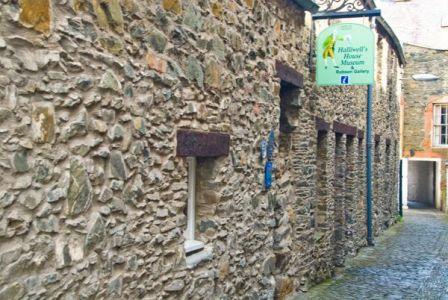Discovering the age of your house
Examining Your House
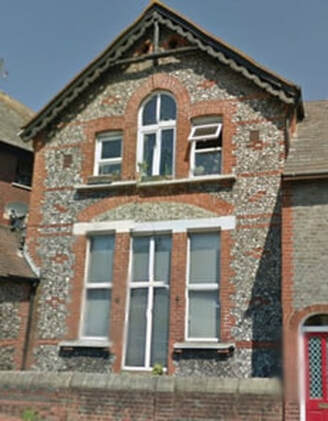 The previous use of this building as a chapel offers
clues to its history
The previous use of this building as a chapel offers
clues to its history
House building styles
Take a look at the house starting with the exterior. Using our checklist note down features about your house. Is it in a small town or hamlet, is it in a street of other similar houses or is it isolated. Is it likely to have been part of a larger building or was its origins in manufacturing or commerce. Many village and towns started life as a small settlement, often close to the market and parish church. The suburbs were developed later. Sometimes village were engulfed by new development and that is why the older part of the town is in the centre. This is covered in more detail on Howoldismyhouse. So returning to your building examine the front elevations to see if this looks different or later then the main structure. Look round the back of the house too as this is less likely than the front to have bene resurfaced.
Take a look at the general shape of the building. Until the 18th century most smaller houses were only one room deep. After this period house two rooms deep became popular.
Sometimes you can see that the front and rear walls have been raised to give more headroom, often the pitch of the roof is flattened. Sometimes the raising was done at the front only.
Look to see if the house has been extended. It is often easy to identify where there is a change of walling material or the windows may be of a later architectural period.
Check where the material to build the house may have come from. Is it local brick or stone? Materials were not transported long distances for ordinary houses until cheaper transport became available by canal, road or even rail. Great place to start is How to Date your House on the Howoldismyhouse.com website.
TIP: Keep Records - It is vital that you keep a record of everything you do and see. Go to our Keeping Records section where there are tips to help you keep a record of your researches.
Here are example of houses built using local material.
House building styles
Take a look at the house starting with the exterior. Using our checklist note down features about your house. Is it in a small town or hamlet, is it in a street of other similar houses or is it isolated. Is it likely to have been part of a larger building or was its origins in manufacturing or commerce. Many village and towns started life as a small settlement, often close to the market and parish church. The suburbs were developed later. Sometimes village were engulfed by new development and that is why the older part of the town is in the centre. This is covered in more detail on Howoldismyhouse. So returning to your building examine the front elevations to see if this looks different or later then the main structure. Look round the back of the house too as this is less likely than the front to have bene resurfaced.
Take a look at the general shape of the building. Until the 18th century most smaller houses were only one room deep. After this period house two rooms deep became popular.
Sometimes you can see that the front and rear walls have been raised to give more headroom, often the pitch of the roof is flattened. Sometimes the raising was done at the front only.
Look to see if the house has been extended. It is often easy to identify where there is a change of walling material or the windows may be of a later architectural period.
Check where the material to build the house may have come from. Is it local brick or stone? Materials were not transported long distances for ordinary houses until cheaper transport became available by canal, road or even rail. Great place to start is How to Date your House on the Howoldismyhouse.com website.
TIP: Keep Records - It is vital that you keep a record of everything you do and see. Go to our Keeping Records section where there are tips to help you keep a record of your researches.
Here are example of houses built using local material.
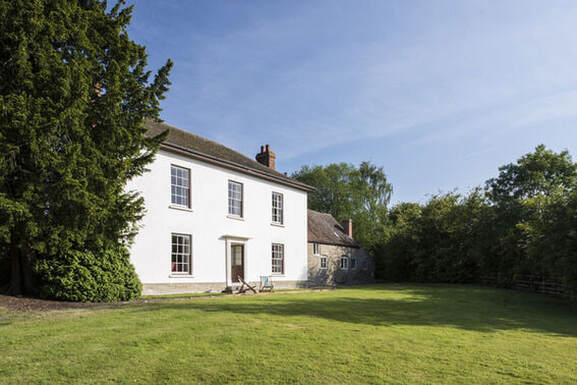
Timber Frame Houses
This was often the most common form of building technique for small and medium sized houses since Medieval times. Dating a timber frame building can be difficult due to the ease by which it could be altered over the years.
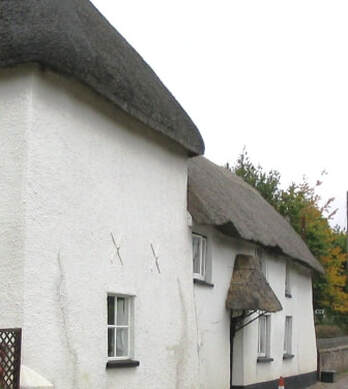
Cob Houses
Small houses and cottages could be made of this mix of chalk, mud and straw which was used since medieval times particularly in an areas where timber was scarce. As the predominant material was chalk it is more likely found in chalk downland areas.
The early Cob houses could be plastered and lime washed Cob was used until the nineteenth century by which time it was often faced with tiles or brickwork.
Walls of cob houses tend to be very thick and sometimes the corners rounded
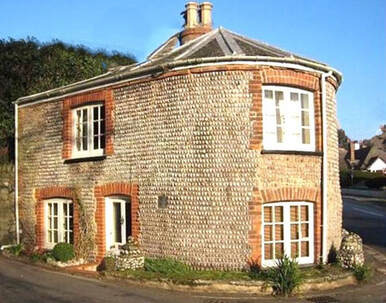 Pebblestone Cottage Pebble walling is popular on the Norfolk coast but there are examples in Brighton, Worthing and many other seaside resorts. This curiosity is almost circular which might suggest it could have been a toll house but it is most likely a seaside retreat
Pebblestone Cottage Pebble walling is popular on the Norfolk coast but there are examples in Brighton, Worthing and many other seaside resorts. This curiosity is almost circular which might suggest it could have been a toll house but it is most likely a seaside retreat
Stone Built Houses
Stone houses became more popular after the seventieth century. They could only be built when there was a plentiful supply of good stone or rubble such as quarries or where older substantial buildings have been demolished. Houses built of regular shaped stone were naturally more expensive than those built using locally sourced rubble. External walls could often be lime washed but later it was removed as it became fashionable to have stone faced homes
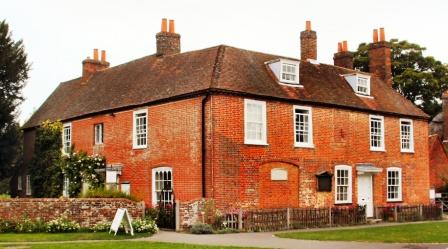
Brick Built Houses
Brick have been used to build homes since the Romans introduced them but it was not until the 16th century that it became a popular choice of material.
Read more about the use of brick and see examples of the types of brick styles by clicking this link to bricks Roofs
When examining a house to determine how old it is you have to bear in mind that roofs wear out far more frequently than external walls. It has been estimated that a tile or slate roof needs replacing every 100 years whilst thatch has an even shorter life. Also we have to consider that each time a roof is changed it is likely to be using cheaper or more modern materials. So you cannot always rely on what you see today.
From the medieval period most small houses were thatched or covered in shingles (slabs of oak made to look like tiles.
Tiles were first used in the South East of England around 1500. Pantiles appeared first in East Anglia around the seventeenth century
Slates were mostly used in areas where they were quarried. Mainly in Wales, the Lake district and Cornwall, But as transport , particularly rail became more available Welsh slate was transported to the whole country.xterior
Take a look at the house itself starting with the exterior. Examine the front elevations to see if this looks different or later then the main structure. Look round the back of the house too as this is less likely than the front to have bene resurfaced.
Take a look at the general shape of the building. Until the 18th century most smaller houses were only one room deep. After this period house two rooms deep became popular.
Sometimes you can see that the front and rear walls have been raised to give more headroom, often the pitch of the roof is flattened. Sometimes the raising was done at the front only.
Look to see if the house has been extended. It is often easy to identify where there is a change of walling material or the windows may be of a later architectural period.
Check where the material to build the house may have come from. Is it local brick or stone? Materials were not transported long distances for ordinary houses until cheaper transport became available by canal, road or even rail.
Brick have been used to build homes since the Romans introduced them but it was not until the 16th century that it became a popular choice of material.
Read more about the use of brick and see examples of the types of brick styles by clicking this link to bricks Roofs
When examining a house to determine how old it is you have to bear in mind that roofs wear out far more frequently than external walls. It has been estimated that a tile or slate roof needs replacing every 100 years whilst thatch has an even shorter life. Also we have to consider that each time a roof is changed it is likely to be using cheaper or more modern materials. So you cannot always rely on what you see today.
From the medieval period most small houses were thatched or covered in shingles (slabs of oak made to look like tiles.
Tiles were first used in the South East of England around 1500. Pantiles appeared first in East Anglia around the seventeenth century
Slates were mostly used in areas where they were quarried. Mainly in Wales, the Lake district and Cornwall, But as transport , particularly rail became more available Welsh slate was transported to the whole country.xterior
Take a look at the house itself starting with the exterior. Examine the front elevations to see if this looks different or later then the main structure. Look round the back of the house too as this is less likely than the front to have bene resurfaced.
Take a look at the general shape of the building. Until the 18th century most smaller houses were only one room deep. After this period house two rooms deep became popular.
Sometimes you can see that the front and rear walls have been raised to give more headroom, often the pitch of the roof is flattened. Sometimes the raising was done at the front only.
Look to see if the house has been extended. It is often easy to identify where there is a change of walling material or the windows may be of a later architectural period.
Check where the material to build the house may have come from. Is it local brick or stone? Materials were not transported long distances for ordinary houses until cheaper transport became available by canal, road or even rail.
Roofs
When examining a house to determine how old it is you have to bear in mind that roofs wear out far more frequently than external walls. It has been estimated that a tile or slate roof needs replacing every 100 years whilst thatch has an even shorter life. Also we have to consider that each time a roof is changed it is likely to be using cheaper or more modern materials. So you cannot always rely on what you see today.
From the medieval period most small houses were thatched or covered in shingles (slabs of oak made to look like tiles.
Tiles were first used in the South East of England around 1500. Pantiles appeared first in East Anglia around the seventeenth century
Slates were mostly used in areas where they were quarried. Mainly in Wales, the Lake district and Cornwall, But as transport , particularly rail became more available Welsh slate was transported to the whole country.
When examining a house to determine how old it is you have to bear in mind that roofs wear out far more frequently than external walls. It has been estimated that a tile or slate roof needs replacing every 100 years whilst thatch has an even shorter life. Also we have to consider that each time a roof is changed it is likely to be using cheaper or more modern materials. So you cannot always rely on what you see today.
From the medieval period most small houses were thatched or covered in shingles (slabs of oak made to look like tiles.
Tiles were first used in the South East of England around 1500. Pantiles appeared first in East Anglia around the seventeenth century
Slates were mostly used in areas where they were quarried. Mainly in Wales, the Lake district and Cornwall, But as transport , particularly rail became more available Welsh slate was transported to the whole country.
More Links to Help You
Great place to start is How to Date your House on the Howoldismyhouse.com websit
Excellent article by house historian , Melanie Backe-Hansen The evolution of the British home form the Georgian era to the present day
A very simple but useful quiz to help you determine the age of your house is at House Buy Fast site
An introduction to architecture with pages on building types, architectural styles and traditions and building materials and methods of construction. Looking at Buildings
More detailed descriptions of buildings listed as being of special architectural or historic interest have been published by the Department for culture, media and sport
English Heritage is another government body that has major responsibilities in conservation, giving advice, registering and protecting the historic environment. Here you can find details about all 360,000 English Heritage Listed buildings
In Scotland, copies of statutory lists of buildings are held at theNational Monuments Record for Scotland
A searchable database is available on the Historic Scotland
For enquiries about historic buildings in Wales, contact the National Monuments Record of Wales
Historic Scotland is an executive agency of the Scottish Government and we are charged with safeguarding the nation’s historic environment and promoting its understanding and enjoyment on behalf of Scottish Ministers.
The Royal Commission on the Ancient and Historical Monuments of Wales is responsible for ensuring that Wales' archaeological, built and maritime heritage is authoritatively recorded and understood.
Historic Houses Association is dedicated to supporting Britain's historic houses, castles and gardens - and helping visitors to enjoy them!
Britain Express looks at English architecture and the philosophies of building styles and the periods.
The Geffrye Museum shows the changing style of the English domestic interior in a series of period rooms from 1600 to the present day.
Looking at Buildings provides an introduction to architecture with pages on Building Types, architectural styles and traditions and building materials and methods of construction descriptions of architectural aspects.
Museum of Domestic Design & Architecture (MoDA) is better known as the museum of the history of the home’.
Pevsner Architectural guides Links to the famous Pevsner Architectural Guides series
Building History is a good website that sets out information to help research any historic building
If you are researching a Victorian or Edwardian house history have a look at the excellent Victorian Society
British Association for Local History aims to encourage and assist the study of Local History as an academic discipline and as a rewarding leisure pursuit for both individuals and groups.
An excellent website is British History Online which provides a digital library containing some of the core printed primary and secondary sources for the medieval and modern history of the British Isles.
Open learn has a section on house history
The BBC has a useful section on Using Written Archives to Discover the History of your House
If you live in London and you want your house history traced try here traced try Your history London
The BBC's history pages provides access to a huge, diverse amount of historical information.
Channel 4 also has a number of websites for its historical programmes.
In Search of Scotland is a complementary site to the BBC's new series exploring the history of Scotland.
Also Scotland History is a guide to Scottish history resources.
History.uk.com, which describes itself as 'the world's largest free-to-use database of British history'. And has interesting articles on house histories.
A totally free-to-use and non-profit making enormous British website is the PastTimesProject which incorporates 7 completely different huge component sections including sharing memories, finding lost ancestors or friends, sharing the best heritage sites to visit, in which members from around the world interact in real time.
One place studies considers our ancestors in their physical and social context. By learning about your ancestors' neighbours and studying the historical environment and events, big and small, that took place within a village, you can gain a greater understanding of your own genealogy. Which is what Tracemyhouse is all about.
An American site but never the less useful is MyHouseHistory. net
Excellent article by house historian , Melanie Backe-Hansen The evolution of the British home form the Georgian era to the present day
A very simple but useful quiz to help you determine the age of your house is at House Buy Fast site
An introduction to architecture with pages on building types, architectural styles and traditions and building materials and methods of construction. Looking at Buildings
More detailed descriptions of buildings listed as being of special architectural or historic interest have been published by the Department for culture, media and sport
English Heritage is another government body that has major responsibilities in conservation, giving advice, registering and protecting the historic environment. Here you can find details about all 360,000 English Heritage Listed buildings
In Scotland, copies of statutory lists of buildings are held at theNational Monuments Record for Scotland
A searchable database is available on the Historic Scotland
For enquiries about historic buildings in Wales, contact the National Monuments Record of Wales
Historic Scotland is an executive agency of the Scottish Government and we are charged with safeguarding the nation’s historic environment and promoting its understanding and enjoyment on behalf of Scottish Ministers.
The Royal Commission on the Ancient and Historical Monuments of Wales is responsible for ensuring that Wales' archaeological, built and maritime heritage is authoritatively recorded and understood.
Historic Houses Association is dedicated to supporting Britain's historic houses, castles and gardens - and helping visitors to enjoy them!
Britain Express looks at English architecture and the philosophies of building styles and the periods.
The Geffrye Museum shows the changing style of the English domestic interior in a series of period rooms from 1600 to the present day.
Looking at Buildings provides an introduction to architecture with pages on Building Types, architectural styles and traditions and building materials and methods of construction descriptions of architectural aspects.
Museum of Domestic Design & Architecture (MoDA) is better known as the museum of the history of the home’.
Pevsner Architectural guides Links to the famous Pevsner Architectural Guides series
Building History is a good website that sets out information to help research any historic building
If you are researching a Victorian or Edwardian house history have a look at the excellent Victorian Society
British Association for Local History aims to encourage and assist the study of Local History as an academic discipline and as a rewarding leisure pursuit for both individuals and groups.
An excellent website is British History Online which provides a digital library containing some of the core printed primary and secondary sources for the medieval and modern history of the British Isles.
Open learn has a section on house history
The BBC has a useful section on Using Written Archives to Discover the History of your House
If you live in London and you want your house history traced try here traced try Your history London
The BBC's history pages provides access to a huge, diverse amount of historical information.
Channel 4 also has a number of websites for its historical programmes.
In Search of Scotland is a complementary site to the BBC's new series exploring the history of Scotland.
Also Scotland History is a guide to Scottish history resources.
History.uk.com, which describes itself as 'the world's largest free-to-use database of British history'. And has interesting articles on house histories.
A totally free-to-use and non-profit making enormous British website is the PastTimesProject which incorporates 7 completely different huge component sections including sharing memories, finding lost ancestors or friends, sharing the best heritage sites to visit, in which members from around the world interact in real time.
One place studies considers our ancestors in their physical and social context. By learning about your ancestors' neighbours and studying the historical environment and events, big and small, that took place within a village, you can gain a greater understanding of your own genealogy. Which is what Tracemyhouse is all about.
An American site but never the less useful is MyHouseHistory. net
The HouseLand Registry
Maps Manorial Records Other Records Postcards & Photos Enclosures Books & House histories Church & Parish Records |
The People |
|
OUR ADVERTISING POLICY - This website receives no funding or any other form of award and is run voluntarily to provide information to those who want to trace the history of their house. We would like to say thank you to all those who have or will in future click on the advertisements they find on this page. We know they can be a nuisance or distraction and we try to make sure that they are relevant to the information we provide and our readers. However the modest income we receive from them keep the web site going. So thank you.

